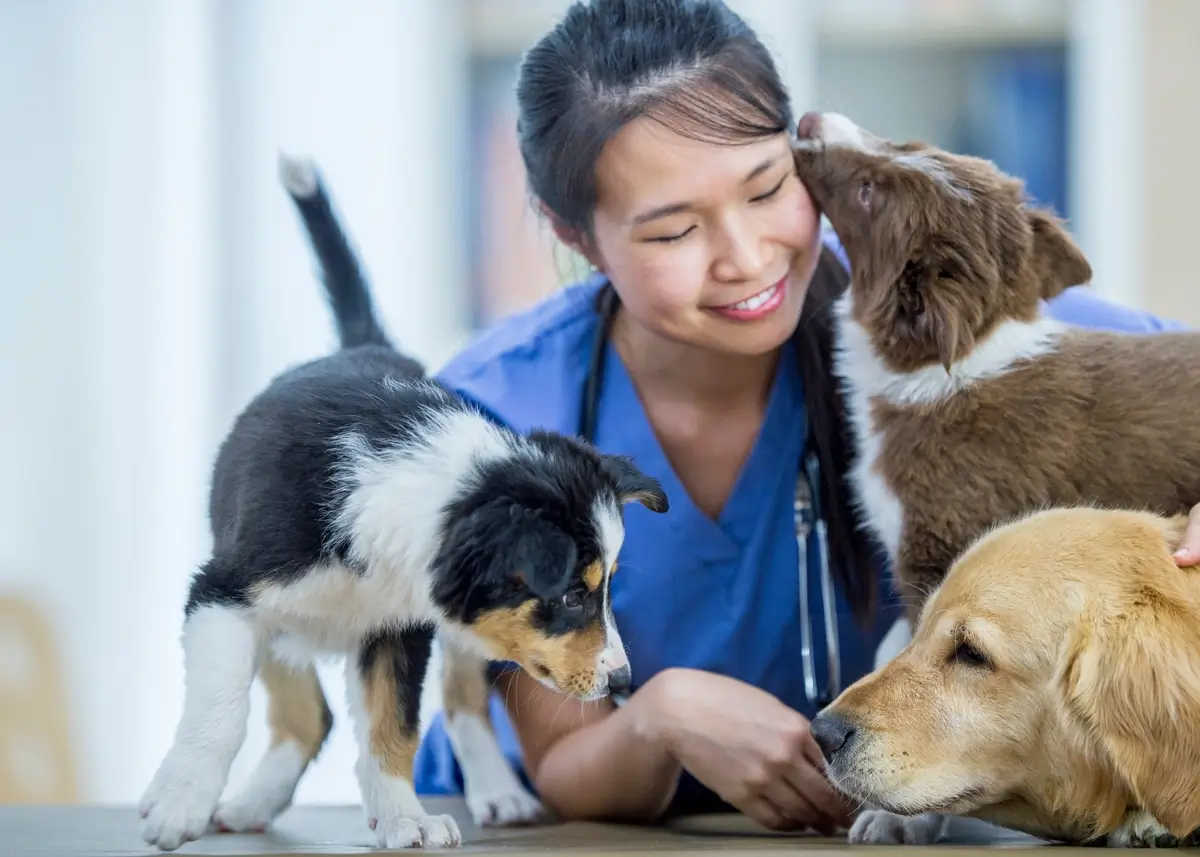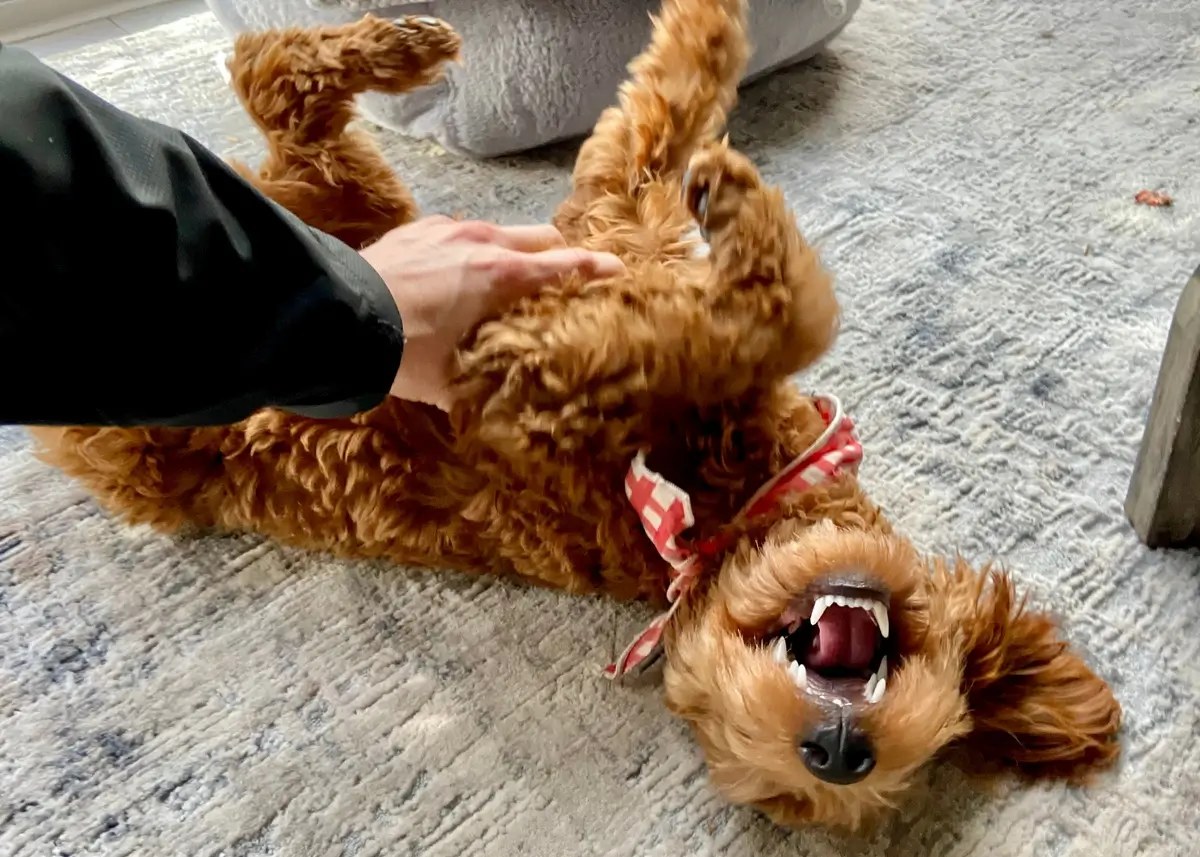As Valentine’s Day is in the rearview mirror, the lull between holidays and after the busy season is a great time to assess your pet’s wellness care. You already did a great job of showing love to your puppy on Valentine’s Day, but are you doing all you can for your pet’s wellness?
We’d do anything for our pets, but it’s always good to think critically to see if we are doing everything possible. You might be surprised to find some empty boxes not ticked off when you write down everything you can think of when the term “pet wellness” comes to mind. Our suggestions will help you make a pet wellness checklist for your puppy to allow them to put their best paw forward in life.
It may be tempting to skip out on wellness visits, dental care, or preventative flea, tick, and heartworm medication, but you’re only shortchanging your puppy when you put off these areas of care. Being “well” entails ensuring your puppy has the best chance of a healthy, fulfilling life. Once you think about each component you need, you’ll be on your way to making steps you can take for pet wellness.
Factors to Consider When Making a Pet Wellness Checklist
As puppy paw-rents, we cherish the unconditional love our pets provide and strive to give them the happiest, healthiest lives possible. However, ensuring our beloved companions thrive requires more than just cuddles and tasty treats. It requires a commitment to comprehensive pet wellness care.
Wellness exams at regular veterinarian visits
A veterinarian’s office is not where you only go if there is an emergency. You should know how to choose the best veterinarian for your dog who understands the nuances of young puppies and won’t push unnecessary tests or procedures. Trusting your vet is key in a partnership to maintain your puppy’s health, as you are working together as a team for the same common goal.
Puppy owners should bring in their furbabies on a schedule for well visits. Your first visit with your Pawrade puppy to a licensed veterinarian should be within 3 days (72 hours) after arrival. The next visits will be every 3-4 weeks starting at 6-8 weeks of age and ending at 16-20 weeks. From that point, an annual exam is usually fine with quick visits for boosters or vaccines like Bordetella for boarding purposes. Work with your veterinarian for a care schedule for senior dogs as they have more frequent health issues cropping up as they age.
You may wonder, “What happens at a routine well visit for puppies at the veterinarian?” While every visit can be different, here are the things commonly done at a puppy well visit:
- Check vitals like height, weight, temperature, etc.
- Questions and answers about your dog’s breed, current lifestyle, and health status to establish a baseline for the visit
- Discuss exercise needs and ways to meet them
- Check to see which brand of dog food you’ve chosen and make recommendations
- Ask about bathroom habits to troubleshoot any concerns
- Offer a recommended vaccination schedule according to your puppy’s needs, geographic location, and more
- See how training and home life with a puppy are going
- Recommend vaccines according to the schedule
- Discuss preventative care with flea, tick, and heartworm medications, education about breed-specific health challenges, allergies, dental care progress, skin, eye, and ear health, weight management, and more
- Perform a nose-to-tail full body exam including heart and lung monitoring, eye & ear exam, checking for lymph nodes, palpating for organ health, rectal exam, reflexes, and looking at gait and mobility.
- Any other concerns you may have about now or in the future
A wellness checkup for dogs will look different for every puppy. Veterinarians use your individual puppy’s needs to craft a plan just for them because a one-size-fits-all plan is too broad to address everyone’s needs.
Being financially prepared for pet wellness
Owning a puppy can be expensive. There are so many more costs associated with raising a puppy that begin when you bring them home. To be a financially responsible puppy owner, you’ll need to look at your budget to find room to set aside money for future pet care and expenses. Being aware of what these ballpark figures are will help you avoid sticker shock and be prepared to spend the necessary money for your puppy’s health and well-being.
Some expenses you may encounter in your efforts for maximum pet wellness are:
- Pet Insurance
- Mircochipping
- Regular vet visits
- Emergency vet fund
- Spaying and neutering
- A safe enclosure like a dog crate
- Extra testing, screenings, and labs
- Preventative and prescribed medications
- High-quality nutritious food and supplements
- Mentally stimulating toys for puppies to keep them busy
- Leashes, harnesses, waste bags, and practical accessories
- Grooming needs, whether professional or DIY dog grooming at home
Pet insurance
When shopping for insurance plans, you may wonder what the difference is between pet insurance and a wellness plan. Pet insurance policies help shoulder some costs of raising a puppy when there are unexpected expenses from an accident or illness. A separate wellness plan covers routine care and helps you budget by spreading costs throughout the year.
While some people opt to not purchase pet insurance or wellness plans for dogs, it will give you peace of mind and help stretch those dollars. Read your plan’s terms and conditions carefully to see what is and is not covered. You may feel like you’re shelling money out upfront, but the uninsured emergency vet bill will make you glad you made the choice.
Nutrition
You may be overwhelmed by the sheer amount of pet food choices on the market. What’s the difference between the cheapest vs. the most expensive dog food in the aisle? Do I feed my puppy kibble, wet food, a raw diet, or a fresh pet food subscription service? A discussion with your licensed veterinarian or other canine professional will help you select the very best high-quality food for your growing puppy. Feeding your puppy the correct amount of vitamins, minerals, and calories can help their growing bodies thrive. As your puppies grow into adults, be sure to know when to switch your puppy to adult food. A puppy’s high-caloric contents are not what a young adult puppy needs, so be sure to pick the right formula for your puppy’s age and height.
A safe space to call their own
Puppies can get overstimulated and exhausted quickly due to all the excitement in the world, playtime that gets them riled up, or not getting enough sleep. They may also be frightened by fireworks or thunder or need a place to escape the raucous hustle and bustle of the household.
Providing a safe space for your puppy to retreat and rest gives your puppy a den-like environment of cozy safety. It’s a valuable tool in pet wellness, as rest in a stress-free environment is crucial to a puppy’s brain and bodily development. It doesn’t have to be a crate in particular. Any space enclosed using sturdy materials with fresh airflow and room enough to lie down, stand, and turn around placed in a spot out of the way will do the trick. Crate training your dog offers your dog a way to get some much-needed sleep and reduces anxiety in puppies. Your puppy’s safe space can reduce unwanted behaviors and help regulate their sleep schedules.
Exercise and mental stimulation
One of the areas we need to examine when it comes to pet wellness is if we are exercising our puppies’ brains and bodies enough to keep them in optimal shape. There are two types of exercises: physical through rigorous activity to keep the body fit, and mental stimulation to keep the brain sharp.
An underexercised dog can exhibit boredom and anxiety which lead to undesirable behaviors. Not only does exercise keep your dog busy, but it also reduces joint issues, keeps pet obesity at bay, improves cardiovascular functions, and prolongs their lifespan.
You don’t have to commit to walking an hour a day though. Make sure you understand how much exercise your dog breed needs and be consistent with your dog’s activity. If you’re stumped beyond walking a dog or playing fetch, check out our suggestions on 18 ways to exercise your puppy for some fun ideas to keep things fresh and exciting.
We Take Pet Wellness Seriously at Pawrade
At Pawrade, we're here to facilitate adoptions per the law and best ethical practices. We pride ourselves on our relationships with our trustworthy breeder partners because they have extensive knowledge of their breed’s development and well-being. Breeders submit their whelping areas and USDA license for kennel approval when applying for our selective program.
During the time our puppies for sale are in the breeder’s care before they’re ready to go home with their new parents, we require a unique, detailed veterinary examination, ensuring a full health assessment and that necessary treatments are conducted. This level of transparency safeguards the well-being of your new furry friend by providing you as a new pet owner with insights into your pet's health and reducing unexpected financial burdens.
All puppies for sale are covered with 30 Days of MetLife insurance (with a few exceptions) and either a 1- or 3-year comprehensive health guarantee depending on the breed. When puppies leave for your new home, your puppy is in sound condition before leaving the breeder’s. All puppies are up-to-date on vaccinations at the time of your puppy’s delivery.
After your puppy arrives in your loving arms, we require a 72-hour veterinarian examination after delivery for every adoption. This ensures that puppies are treated humanely during the transition from the breeder's ownership to your care.
If you have any questions about how Pawrade ensures the well-being of all our puppies for sale, contact our Puppy Concierge team to get started finding your healthy four-legged friend.





